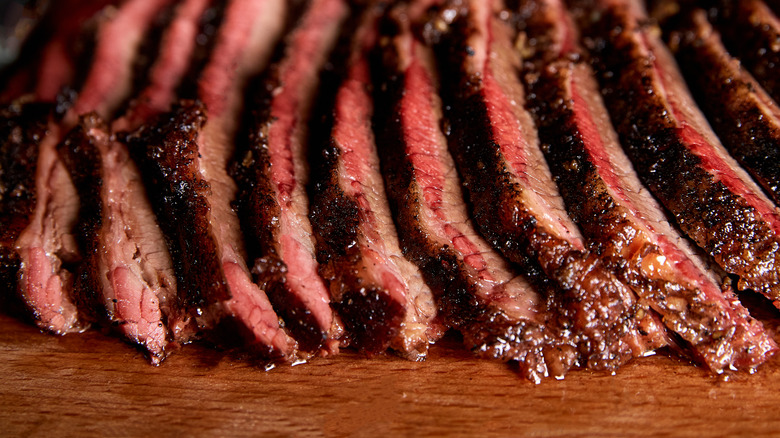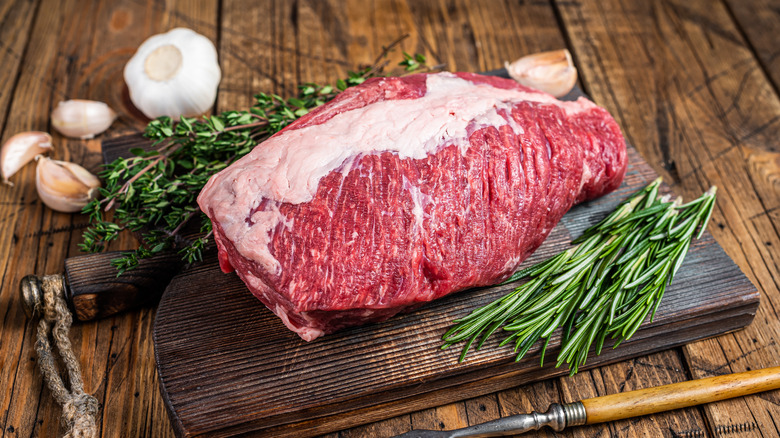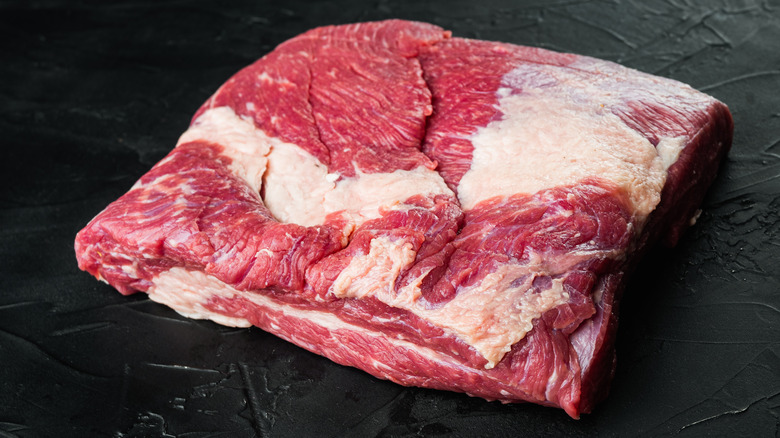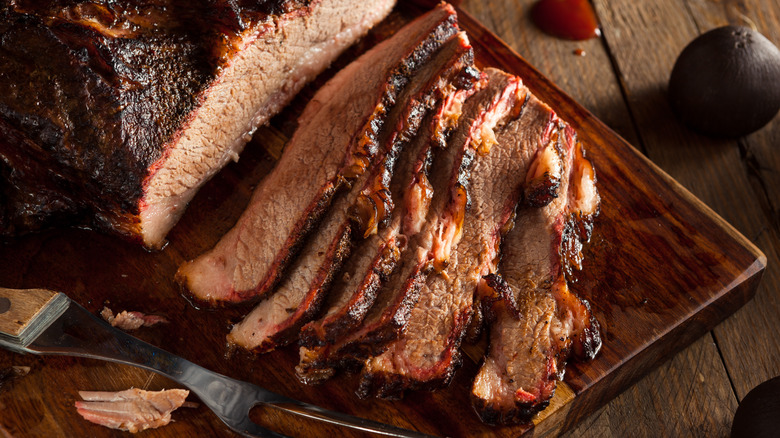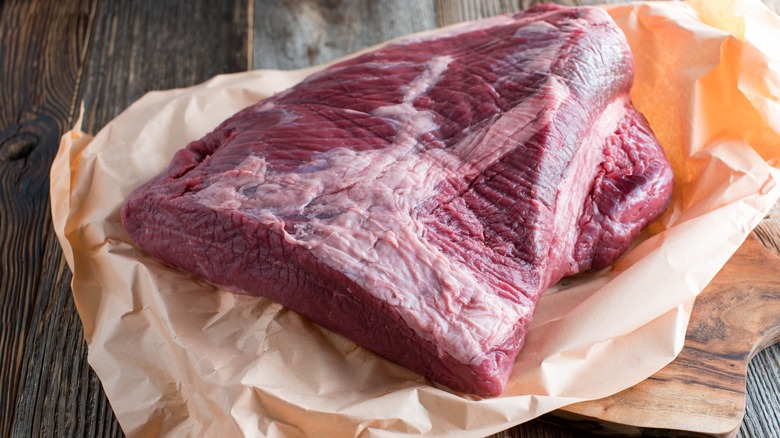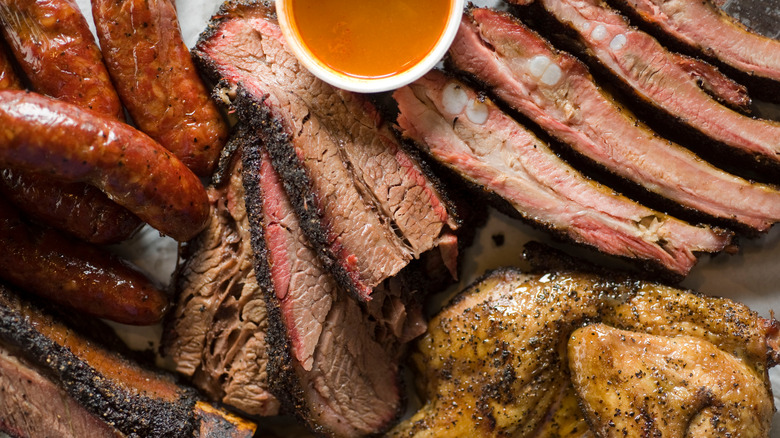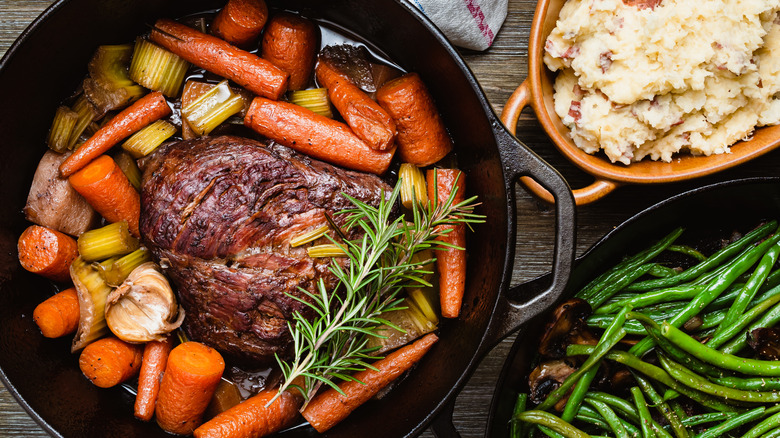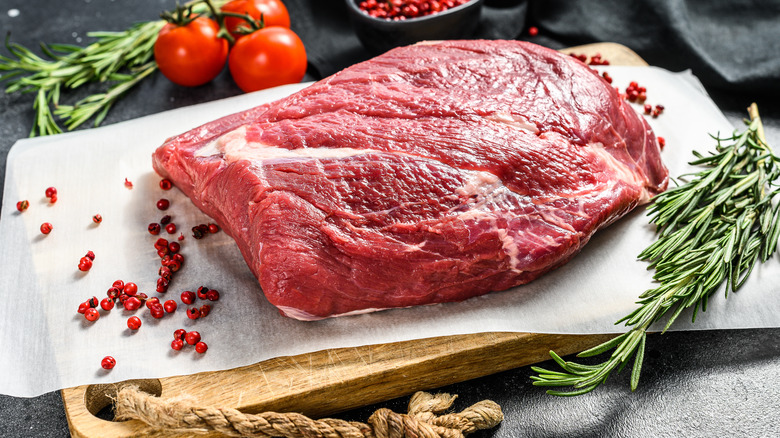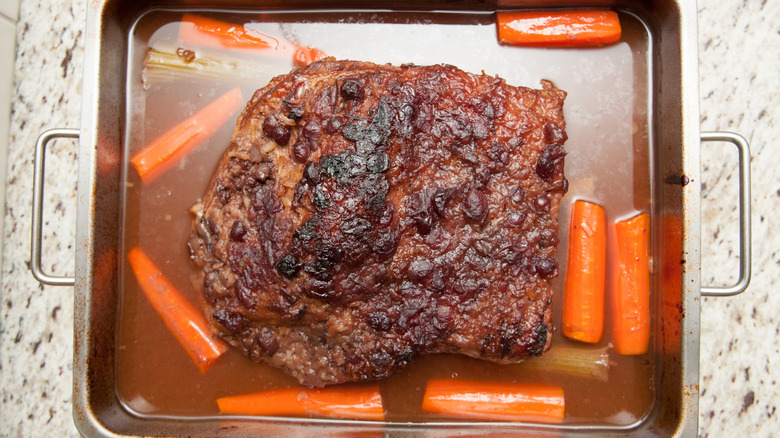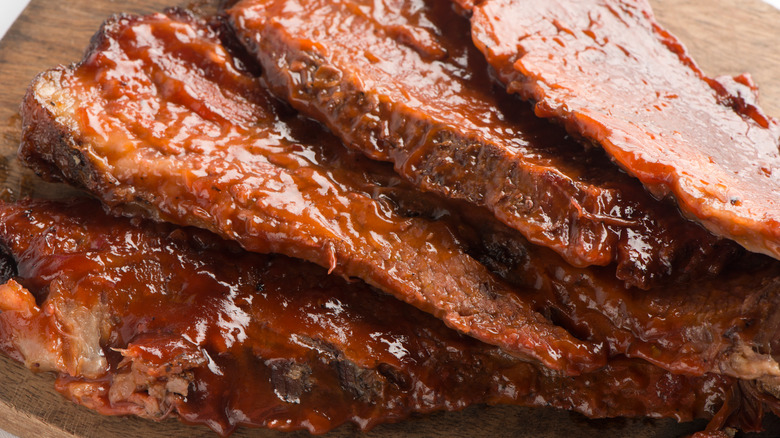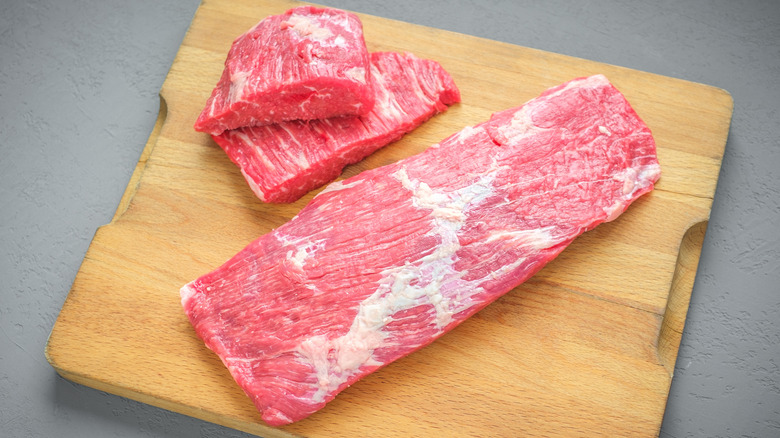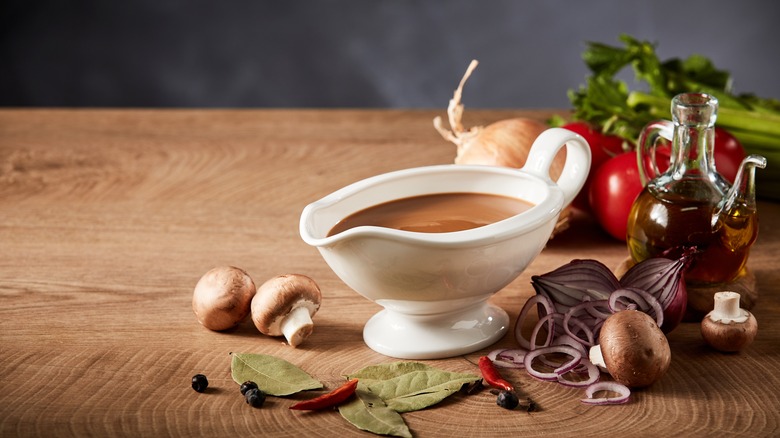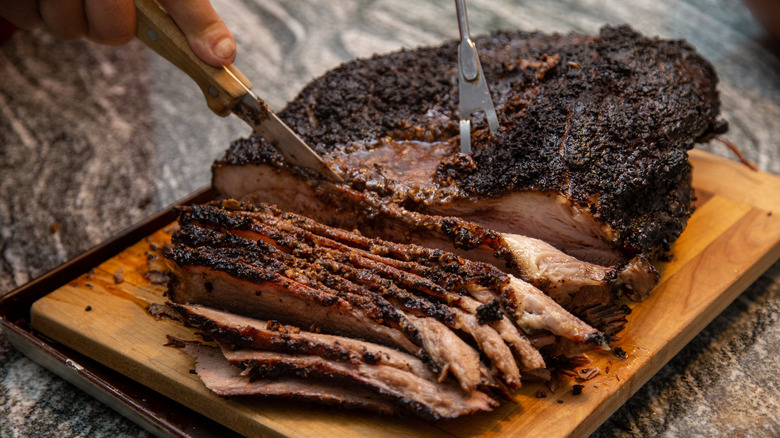What Exactly Is Brisket And Here's How To Cook It
For many of us, a big plate of brisket on the table is a symbol of togetherness. Whether it's a slow-smoked brisket that's been sliced for sandwiches served at an outdoor family reunion, a cozy pot roast shared with close friends, or the classic braised brisket traditionally served at Jewish holiday celebrations, this is a dish that's meant to be cooked with care and shared with others.
But while beef brisket meals are not known to be formal or fussy, they're not necessarily easy either, especially for novice cooks. Coming from the forequarters of the cow (that's just above the front legs and below the shoulders), the brisket is comprised of well-exercised (in other words, tough) muscle, along with a high proportion of connective tissue and fat. This means you can't simply quick-fry it like a steak or chop and expect it to have the tender, unctuous mouthfeel you hope to enjoy.
Rather, brisket requires and rewards special treatment. Fear not, however, as we can assure you that none of this is rocket science. Armed with a few useful facts and easy expert tricks, you too can achieve brisket perfection.
There are two brisket cuts — know the pros and cons of each
The first trick for cooking a perfect brisket is starting with the right piece of meat. For this, it's important to know that a whole brisket (sometimes called a full packer) contains two separate cuts: the flat cut and the point cut. Each has its own distinct character and advantages for cooks, so understanding the difference can be critical.
The point (or tip) cut is typically the more expensive of the two. It has more fat marbling than the flat, but is irregularly shaped and therefore can be challenging to cook through evenly, The flat, as its name implies, actually does lie flat, making it easier to cut into even portions. This makes it a popular choice with chefs, who need to keep their preparations consistent and the appearance of their finished dishes uniform.
While the meat in the flat is leaner and less marbled than that of the point, it comes topped with a thick fat cap, which can help ensure the meat stays moist and tender as it cooks. And while expert pitmasters can and do successfully smoke whole briskets, some cooks advise treating the point and flat as distinct cuts. "If using the tips, cook them in a separate pan than the flats," Mica Talmor, chef and owner of the restaurant Pomella in Oakland, California, tells Mashed.
Shop for a well-marbled brisket
When it comes to brisket, fat is flavor. There's no point in pretending that a properly prepared brisket will ever be a diet food. Because the brisket is comprised of dense, tough muscle fiber, it requires a long period of cooking to become pleasantly tender. Yet long-cooked meat can easily become dry and stringy if it is not handled with care. Luckily, brisket comes with a built-in lubricant and flavor enhancer — its fat. If that's properly rendered, the fat will flow into the meat as it cooks and helps to keep it juicy and flavorful. This means that you should seek out a well-marbled brisket for the best results.
If you're shopping for brisket, one easy way to check for a good level of internal fat is to pick up a brisket cut and try to bend it. If it's pliable, then it's more likely to yield more tender meat. Also, it's helpful to understand the different USDA grades for meat quality and aim for the best quality that you can afford. "If your budget allows it, choose high-quality meat and avoid Standard, Commercial, and Select meat cuts — go for Prime instead," chef and pitmaster Joonas Jokiniemi tells Mashed.
Buy more meat than you think you'll need
Brisket used to be known as a budget cut, making it a popular choice for big families seeking to eat cheaply and well. Alas, those days are long gone. As the cut has become more popular, it's become much pricier. The fact that each steer only yields two briskets compounds the problem. So when shopping for brisket, it's understandable that you may want to buy the smallest possible piece that can still comfortably feed your crew. Of course, leftovers the next day would be nice, but so would be having enough left in the bank for your mortgage.
The harsh reality, however, is that you'll probably need to buy more brisket than you think you need, thanks to its changing nature during the cooking process. "It shrinks a lot in the braise so figuring out quantities is challenging," says Talmor. "You have to buy almost double the meat." A good rule of thumb: plan for about half a pound of uncooked brisket per person.
Trim your brisket carefully to ensure even cooking
Brisket can be delicious, but it's rarely if ever a pretty dish. At best, you'll get some even slices of meat with an appetizing sauce on top. It still won't win a beauty contest, though. This is largely because a whole brisket is an irregularly shaped cut of beef, so it'll never have the visual pizzazz of a whole roasted chicken or prime rib.
The uneven shape of brisket not only makes it challenging to present but also to cook evenly. Thus, one of the secrets to brisket success is to seek out a cut that's as evenly shaped as you can find. "As much as possible, try to choose a brisket that is about even thickness all over," Jokiniemi tells Mashed. He also advises steering clear of briskets that taper into a narrow strip of meat. "The narrow part cannot be cut into proper slices," he explains.
Once you've chosen your brisket, cut it into more manageable pieces or trim off problem parts, and remove any silver skin. Talmor uses only flats in her restaurant and cuts each flat along the grain into two pieces. "You end up with wide brisket 'strips' that will cook faster and more evenly," she says. Jokiniemi has another piece of trimming advice: "You should always make sure that the brisket is cold when you start trimming it because a warm brisket will be too soft, which makes it harder to cut it precisely."
Don't leave too much fat on your brisket
As we've previously noted, brisket is a fatty cut, and this fat is essential for moist, flavorful, and tender meat. Without it, your brisket will end up tough, dry, and tasteless. But it's possible to have too much of a good thing, as there's a fine line between a juicy, rich-tasting brisket and an unpleasantly greasy one. This is why chefs and pitmasters recommend trimming off just enough fat to keep your brisket from oozing grease, but not so much that the meat risks drying out.
So, just how much fat should you trim? That will depend on how rich or lean you like your brisket. While some authorities recommend trimming the fat cap down to a thickness of ⅛ inch, others such as Jokiniemi recommend an ideal thickness of ¼ inch.
Also, pay attention to any dense pockets of fat in the meat. You'll want to trim most of those away as well since they won't be able to render out of the meat completely. Be sure to take your time with your trim, too, and pay attention to detail. Use a sharp boning or filet knife and remove the fat in small pieces so you don't accidentally cut off more fat than you want or cut into the meat.
No matter the cooking method, go low and slow
All brisket recipes, regardless of cooking method, include one key ingredient: patience. Because it's such a tough cut, brisket takes a long time to cook, and you can't rush the process by cranking up the heat. "[A] common mistake is to cook the brisket at a too high temperature that will result in the meat being too tough," Jokiniemi tells Mashed. A lower cooking temperature will enable the fat to render out more fully into the meat, helping to keep it tender and juicy.
Thus, the only way to ensure a tender brisket is to allow yourself enough time to cook at a low temperature. That can be a real commitment, with some recipes calling for up to 16 hours for a large brisket if you're using a smoker.
If you're doing a stovetop braise, don't be tempted to boil your braising liquid, either. Instead, keep it at a low simmer. And tempting as it may be, don't try to slice and serve your brisket the moment you remove it from the stove or smoker. Brisket aficionados will tell you it's still not quite done and needs time to rest. "Probably the most common mistake when cooking a brisket is not letting it rest long enough after removing it from the smoker," Jokiniemi notes. "Resting is important because it allows the temperature to get even and the meat juices and rendered fat will redistribute evenly making the meat juicier."
Season your brisket the day before cooking for maximum flavor
Brisket is such a flavorful cut of beef that it doesn't need a lot of seasoning to be good. "I think that a good brisket doesn't really need a complicated seasoning," Jokiniemi says. "It's best to make a simple rub by mixing kosher salt, black pepper, paprika, and garlic powder. This will allow the flavors of the meat and smoke to do the talking instead of covering them with too much spices."
But even if you want to keep your seasonings simple, you will also want to make them count. A brisket is a big piece of meat, so to ensure that whatever seasonings you do use can fully permeate the cut it's wise to season it well before you start cooking. Talmor recommends a really long head start to do this step right. "Salting the meat overnight helps both with flavor and moisture," she says.
Here's how to tell when your brisket is fully cooked
Briskets are at their best when they have been cooked at a low temperature and for several hours. We mean it when we say slow — really large briskets may need to cook for as long as 16 hours. But believe it or not, it's possible to overcook your brisket as well as undercook it. Undercooked brisket will be tough and chewy, while overcooked brisket will be mushy but also dry. While you can salvage overcooked brisket by turning it into chili or another similar dish, this might not be a convenient option if you have hungry dinner guests waiting. And because brisket is such a big (and often expensive) cut, you want to be sure to cook it right.
Fortunately, there are several ways to tell when your brisket is perfectly cooked. For analytical types, an instant-read thermometer plunged into the thickest part of your cut will tell you if it's ready. You should look for a temperature between 195 and 203 degrees Fahrenheit.
However, if you're cooking your brisket on a grill or smoker, don't be tempted to check the temperature too often. That's because repeatedly opening the grill will lower the heat and slow your cooking time even further. If you're a more tactile cook, try sticking a fork or toothpick into your brisket. If it slides in easily without resistance, the brisket is ready.
Want smoked brisket but don't have a smoker? Try this
For many aspiring pitmasters, smoking a perfect brisket is a capstone achievement. Doing so takes patience, skill, and experience to master all the nuances of maintaining an ideal cooking temperature for hours on end. Skilled chefs must also know how to best prepare the oddly-shaped cut for the smoker and track its progress as it cooks. This skill set is rare even among experienced home cooks, which is why most of us are happy to think of smoked brisket as purely a restaurant-based food.
But if you're jonesing for smoked brisket yet don't feel like going out or pulling an all-nighter sitting by your smoker, there's a hands-off, smoke-free way to make a close facsimile: Use a sous vide cooker.
Prep your brisket by coating it with the rub of your choice along with a bit of liquid smoke, then vacuum seal it (or put it in a good-quality ziplock bag and carefully squeeze out any air). Set your sous vide cooker to 135 degrees Fahrenheit, add the vacuum-sealed meat to the water bath, and let it cook for 24 to 36 hours. It probably won't fool any expert barbecue judges, but it'll still be tender, juicy, and carry some smoky flavor.
Think outside the box when seasoning braised brisket
Most of us who grew up eating braised brisket associate it with a very specific flavor profile, probably that of an old family recipe. Keepers of these recipes are sometimes so passionate about them that any deviation, however minor, is considered to be a grievous moral offense. For example, NPR reported on a group of roommates who decided to make a brisket for their Rosh Hashanah celebration by combining their grandmothers' very similar recipes. To a person, every one of their grandmothers declared that they had made it incorrectly.
But while it's good to honor tradition, it's also healthy to shake up your routine from time to time. Contrary to what your grandmother might have told you, there's no law saying that there's only one correct way to season a brisket. In reality, any number of non-traditional flavorings can complement the rich flavor of the meat. For instance, Talmor accents her braised brisket with some unexpected touches, such as pomegranate juice that she adds to her braising liquid along with other Middle Eastern-inspired flavorings. "We add dry fruits, preserved lemons, and roasted onions to the meat," she says. "To make sure they do not overcook, we add them for the final hour of cooking rather than the whole cooking time."
These expert tricks will ensure a silky, grease-free sauce
After you've braised your brisket, you might be tempted to rush it right to the table. It'll probably smell and taste wonderful. And while the braising liquid can make a flavorful accompaniment as-is, if you want to take your brisket game to the next level and turn your meal from good to truly memorable, take a little extra time to turn your braising liquid into a refined sauce.
Yes, like everything else in brisket cookery, this will involve some extra time and planning. "After the meat cools, we take it out of the sauce, skim the fat from the sauce, and reduce it," Talmor tells Mashed. "Most people thicken the sauce with flour, [but] to keep it gluten-free, we use tapioca starch, we also add some gelatin to the sauce to make it shiny, and it helps with thickening."
If you can't fit the cooling, skimming, and thickening steps into your pre-dinner schedule, Talmor recommends a more practical option: "At home, I suggest braising the brisket in advance, slicing it, and warming it up in the sauce before serving."
Here's how to get neat-looking brisket slices
So you've spent hours procuring, trimming, seasoning, and cooking the perfect brisket. But you're not done yet (sorry). You still need to slice the brisket into serving-sized pieces. For some cooks, this step is as critical as all the others. After all, many diners eat with their eyes, and the first visual impression they get will set the tone for the rest of the meal. Thus, your goal here is to produce attractive, even slices.
The first step to getting those just-right slices is to avoid cutting into the brisket right after it's cooked. Instead, let it rest off the heat so it can reabsorb its juices and hold onto them when the meat is served.
Once it's time to cut, get the right tools. "Use a sharp long knife and always cut the brisket into thin slices against the grain," Jokiniemi tells Mashed. "This will make it much easier and more enjoyable to eat, as you will you break up the muscle fibers evenly and make the slices more tender."
